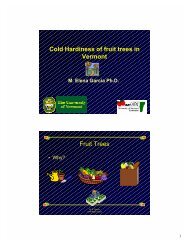Fruit Crop Ecology and Management - UVM Apple Orchard
Fruit Crop Ecology and Management - UVM Apple Orchard
Fruit Crop Ecology and Management - UVM Apple Orchard
Create successful ePaper yourself
Turn your PDF publications into a flip-book with our unique Google optimized e-Paper software.
44<br />
Ecological concept<br />
Host <strong>and</strong> pest development<br />
are synchronized.<br />
Putting it into<br />
practice<br />
Factors that<br />
predispose plants<br />
to pest attack<br />
A variety of stresses can affect<br />
the plant’s ability to defend<br />
itself against attack by pests.<br />
Wounding, for instance, may<br />
<strong>Fruit</strong> <strong>Crop</strong> <strong>Ecology</strong> <strong>and</strong> <strong>Management</strong>: Chapter 2<br />
Windows of opportunity<br />
Treat at the appropriate time<br />
to avoid infection.<br />
To survive, pests <strong>and</strong><br />
pathogens have to time their<br />
development to coincide with<br />
availability of susceptible<br />
host tissue. They often have a<br />
narrow window of opportunity<br />
for infection. One good<br />
example is mummy berry<br />
disease of blueberry. This<br />
fungus infects <strong>and</strong> produces<br />
spores on young succulent<br />
shoots in early spring. These<br />
spores in turn infect the<br />
flowers <strong>and</strong> the developing<br />
berries, which become<br />
mummified. The fungus<br />
overwinters in the mummified<br />
fruit on the ground. The<br />
mummies require a chilling<br />
period followed by a warmup<br />
P. Wharton<br />
A mummified blueberry<br />
with apothecia.<br />
in the spring to become<br />
active, similar to blueberry<br />
plants. Fungal activity<br />
coincides with early plant<br />
growth, so it is important to<br />
protect the young succulent<br />
shoots <strong>and</strong> flowers from<br />
infection.<br />
predispose plants to infection.<br />
Eutypa dieback infections of<br />
grapevines usually begin in<br />
pruning wounds. Leucostoma<br />
canker, a common disease of<br />
peach, nectarine <strong>and</strong> sweet<br />
cherry, often develops in<br />
narrow crotch angles, which<br />
are inherently prone to winter<br />
injury <strong>and</strong> splitting when<br />
branches are laden with fruit.<br />
Hail- <strong>and</strong> frost-damaged pear<br />
<strong>and</strong> apple shoots are<br />
particularly susceptible to the<br />
fire blight bacterium.<br />
Harvesting equipment may<br />
damage fruit plants,<br />
predisposing them to<br />
infestation by wood-boring<br />
insects.<br />
Prior attack by pests or<br />
pathogens may also<br />
predispose plants to further<br />
attack by other pests. Grape<br />
berry moth damage can<br />
promote infection of grapes by<br />
gray mold <strong>and</strong> sour rot<br />
organisms. Nematodes feeding<br />
on strawberry roots can allow<br />
entry of root-rotting fungi such<br />
as Pythium <strong>and</strong> Rhizoctonia,<br />
which cause black root rot. In<br />
addition, strawberry plants may<br />
be predisposed to infection by<br />
freezing or waterlogging of the<br />
soil, soil compaction <strong>and</strong><br />
herbicide damage. Other<br />
stresses, such as drought <strong>and</strong><br />
nutrient deficiencies, can also<br />
render a plant more<br />
susceptible to pests <strong>and</strong><br />
diseases.



